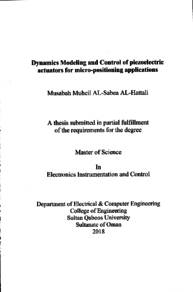Document
Dynamics modeling and control of piezoelectric actuators for micro-positioning applications
Publisher
Sultan Qaboos University
Gregorian
2018
Language
English
Subject
English abstract
Piezoelectric actuators have been widely used in various micro-positioning applications that require ultra-high precision and fast responses. However, modeling and control of piezoelectric actuators were recognized as challenging task. The main difficulties in modeling of piezoelectric actuators appear due to the non-linearity of the system, the inherent hysteresis, creep, and system dynamics vibration. These factors significantly affect the tracking performance of the actuator and may lead to instability. Also, it should be outlined that cach application requires specific control technique. In other words, it is very hard, even though desired, to design tracking controller that suits all applications of piezoelectric actuators.
In this thesis, modelling and tracking control of amplified piezoelectric actuator is investigated. As for the modeling part, Hammerstein model structure is used to describe piezoelectric actuator. In this structure, the hysteresis non-linearity is cascaded with system dynamics model. Bouc-Wen model is employed to describe the hysteretic nonlinearity of a piezoelectric actuator. While a transfer function model is used to describe the linear part of the piezoelectric actuator. Optimization methods are implemented to identify the unknown parameters of both models. The model has been verified experimentally before moving to tracking controller design
Over the last two decades, a number of control schemes have been reported for piezoelectric positioning control. One common approach is the compensation or rejection of the nonlinear effects through adopting feedforward feedback controller. In this thesis, a learning-based feedforward feedback controller is proposed to track a desired reference displacement. This controller is aimed to continuously update the controller's parameters in order to minimize the tracking error in real-time. A proportional-integral (PI) controller is used as a feedback controller along with a learner and inverse feed forward control is designed and implemented in this thesis. Experimental results reveal the tracking error could be reduced to 0.71% of the actuator's maximum displacement, noticeably improving the tracking performance of the piezoelectric actuator.
Member of
Resource URL
Category
Theses and Dissertations

